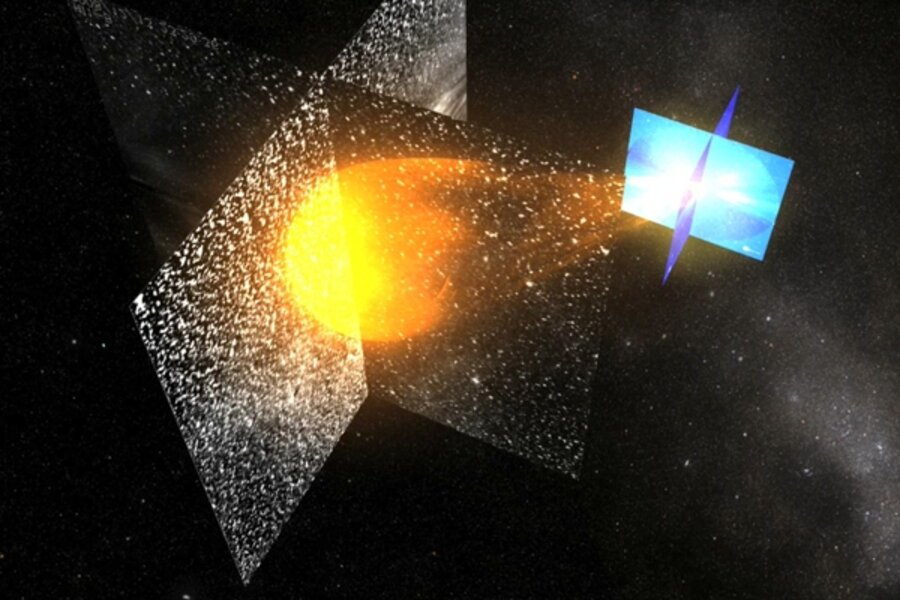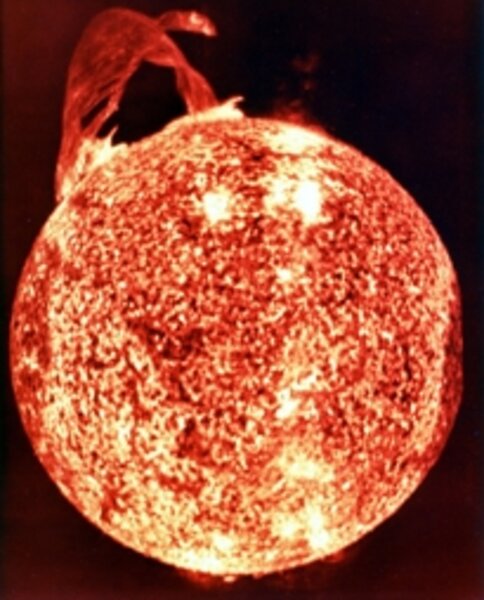Solar storms ahead: Is Earth prepared?
Loading...
When we look at the sun (carefully), it appears to be a uniform, unchanging star. But scientists and engineers have a much different perspective. To them, the sun is a dynamic, chaotic, and poorly understood caldron of thermonuclear forces, one that can spit out fierce bursts of radiation at any time.
And when Earth lies in the path of that blast, the flare can play havoc with power grids, disrupt radio communications, and disturb or disable satellites. Fifty years into the Space Age, Earth has avoided the worst the sun can deliver – so far.
But with the sun entering a period of increased activity, more frequent solar flares could be headed our way. This has many astronomers and companies asking if satellites and power grids are ready.
Solar flares are a product of the sun’s complex chemistry, says Haimin Wang, director of the Space Weather Research Lab at the New Jersey Institute of Technology in Newark. The internal processes of the sun create whirlpools of magnetic force, which slightly lower the surface temperature of the sun, causing what we see as sunspots.
Every 11 years, the sun flips its magnetic north and south. This swap churns up an increased number of sunspots, with the next volatile peak due in 2012. Magnetic energy can build up on the solar surface and then suddenly be released in a massive burst.
This flare, a wave of particles moving at near the speed of light, arrives at Earth shortly after the light itself, which takes about eight minutes to cross the 93 million miles. In other words, sky-watchers won’t know there has been a solar flare until shortly before the radiation arrives.
The burst is largely cushioned by Earth’s atmosphere, according to Madhulika Guhathakurta, program director for the National Aeronautics and Space Administration’s STEREO mission, which studies solar forces from a pair of spacecraft orbiting the sun.
Because of atmospheric padding, the burst poses little risk to people on the ground. However, airplanes at cruising altitude and spacecraft are much more vulnerable. The flash also can zap electronics on satellites, which lie entirely outside the safety of Earth’s atmosphere.
While this initial burst can be dangerous, there’s a much slower wave of energy – a coronal mass ejection (CME) – that really can mess with electronics.
Not every flare produces a CME, and they often occur when no flare is present. When they do spew out, CMEs send strong waves of electromagnetic force our way. The most visible signs of this are the colorful northern and southern lights. But it also has more serious consequences.
For one, it can cause electrical transformers to trip or fail, which can lead to widespread power outages. A particularly powerful CME storm hit Earth in 1921, before electricity played as big a role in daily life. If a burst of similar magnitude hit today, it would interrupt power for as many as 130 million people, according to a recent report by the National Academy of Sciences. In 1989, a geomagnetic storm knocked out power to 6 million people in Quebec.
CMEs also can cause the Earth’s atmosphere to expand temporarily. This can cause low-orbit satellites, such as the constellation of Global Positioning System markers used for navigation, to drag in the denser air. Combined with changes in the transmission of radio waves caused by CMEs, this can lead to errors in positioning. The magnetic field also can induce glitches or even damage satellites.
Ron Mahmot, who manages the Satellite Operations Control Center for the National Oceanographic and Atmospheric Administration (NOAA), isn’t particularly concerned about potential damage from solar activity. NOAA has had only one satellite damaged by a solar flare. The 1994 incident merely shortened the life of the orbital weather-watcher; it did not totally disable it. And for the most critical NOAA satellites, those that monitor the United States from geosynchronous orbit, there is an on-orbit spare in place, with another that was due to launch at the end of April, and yet another already in production.
For satellite TV provider DirecTV, “solar events are nonevents. In the more than 14 years that we’ve been operating satellites, we’ve never experienced a signal outage or interruption of any kind due to solar flares,” a spokesman writes in an e-mail. “The history of communications satellites is one of extraordinary reliability.” Each has shielding and a backup system.
Ms. Guhathakurta of NASA is less certain: “In the past, satellites were built with much greater integrity,” she says. “Now we’re putting up so many satellites, and the electronics are changing. I don’t believe the electronics are as well tested for radiation as in the past.”
Part of the problem, she says, is that we don’t know what the most powerful solar flare might look like. And even if 2012 brings a mild solar peak in terms of quantity, the power of the flares is not directly associated with their number.
“We cannot say anything about the kind of flares or coronal mass ejections we are going to see in a given cycle,” she says. The most powerful solar flare in modern times occurred during a solar lull in 2006.
This unpredictability makes protecting satellites tricky. Guhathakurta’s pair of STEREO spacecraft recently captured the first 3-D image of a CME burst, an important step toward understanding them.
As scientists gather more information, satellite companies have a few tricks to protect their space-bound electronics. It’s hard to determine the effectiveness of shielding – mostly because experts don’t fully know what the sun is capable of spewing out. Another satellite defense would be “safe modes,” where administrators turn off most of the on-board electronics to protect it from going haywire. This can save the satellite but would interrupt whatever services it offered. Safe modes also require some kind of early warning – technology that is nascent at best.






